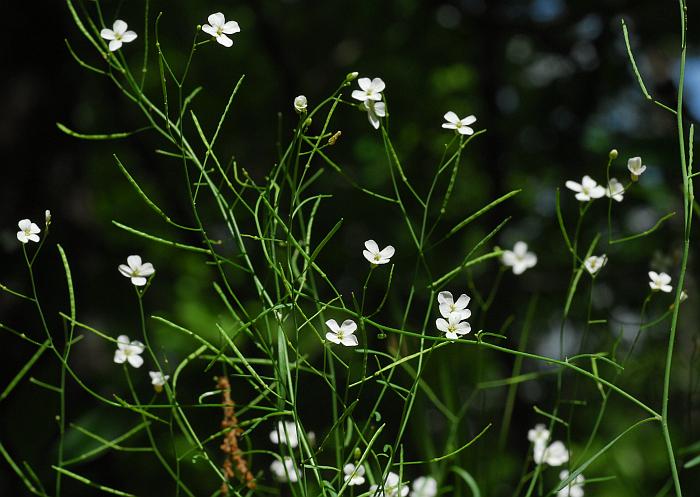Arabidopsis lyrata (L.) O'Kane & Al-Shehbaz
Sand Cress

Native
CC = 8
CW = 3
MOC = 15
© SRTurner
Arabidopsis lyrata (L.) O'Kane & Al-ShehbazSand Cress | |
 |
Native CC = 8 CW = 3 MOC = 15 |
© SRTurner |
|
Family - Brassicaceae Habit - Biennial or perennial forb.
Stem - Ascending to erect, to 30 cm, branched at the base, sparsely pubescent toward the base with simple and 2- or 3-branched, stalked hairs.
Leaves - Basal and alternate. Basal leaves 2-4 cm long, spatulate to oblanceolate, subentire or toothed to more commonly pinnately lobed or divided into 3-9 segments, narrowed at the base to a short petiole, usually pubescent on both surfaces with unbranched and 2- or 3-branched, stalked hairs. Stem leaves 1.0-3.0 cm long, narrowed at the base, not clasping, mostly sessile, the lower leaves often pinnately divided, the upper leaves entire to toothed, mostly glabrous.
Inflorescence - Open terminal racemes of a few flowers. Bracts absent.
Flowers - Sepals 2-4 mm long, oblong-elliptic, green. Petals 4-8 mm long, white, sometimes tinged with light pink or purple. Styles 1.0-1.5 mm long.
Fruit - Siliques, ascending at maturity, straight or slightly arched upward, 1.5-4.5 cm long, flattened parallel to the septum, the valves without nerves. Seeds in 1 row in each locule, 0.9-1.2 mm long, oblong-elliptic in outline, flattened, sometimes narrowly winged at the tip, the surface with a netlike or honeycomb-like pattern of ridges and pits, orangish yellow.
Flowering - April - May. Habitat - Sandstone and dolomite bluffs and adjacent forest areas. Origin - Native to the U.S. Lookalikes - None close. Other info. - In contrast to Missouri's other member of this genus (A. thaliana), Arabidopsis lyrata is both native and conservative, growing only in relatively undisturbed and defined habitats. It is not common in the state, being found in widely scattered areas without a distinct geographical pattern. Its main North American distribution is within the northeastern quadrant of the continental U.S., also extending into Canada. Globally, its distribution is circumboreal. Photographs taken near the Paddy Creek Campground, Texas County, MO, 5-13-2019 (SRTurner). |